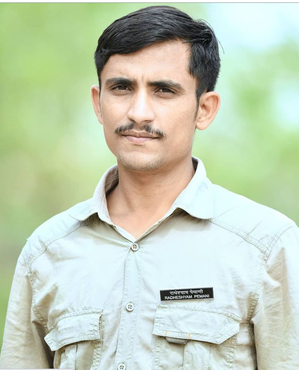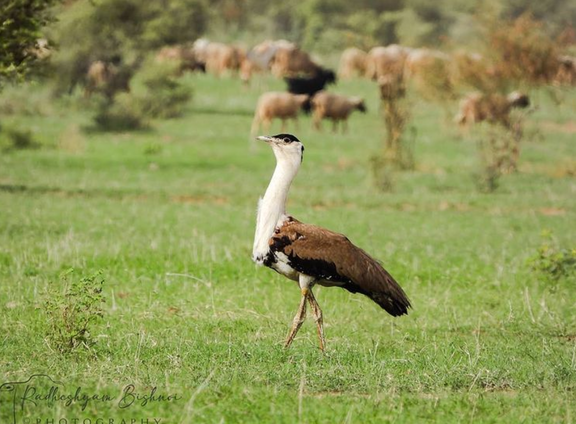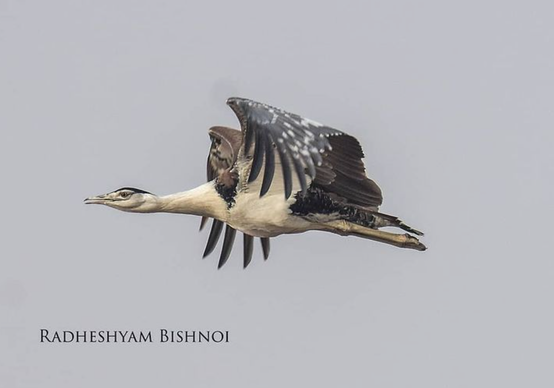|
Radheshyam Pemani Bishnoi, a community conservationist from Rajasthan, was interviewed by YNN members Ekadh Ranganathan and Anooja A as part of our World Ranger Day initiative, “In Nature’s Defence”.
Radheshyam worked with Machia Biological Park as a volunteer for 3 months learning about primary vet care and is using this experience now in Jaisalmer. One of his dreams is to have a good quality wildlife rescue centre in Jaisalmer. Radheshyam works under the guidance of the Ecology, Rural Development and Sustainability Foundation that focuses on community conservation initiatives in this crucial GIB habitat. He is closely mentored by conservationist Dr. Sumit Dookia, Assistant Professor of the Guru Gobind Singh Indraprastha University’s School of Environment Management. |
When I started studying in school, I was already interested in animals. Being born into the Bishnoi community, I held values for animal rescue and conservation. At first, I used to take in and heal any injured wildlife since our forest department was not equipped to rescue these animals at the time. WheneverI nursed an injured animal back to health, I felt really satisfied and loved that part of my job. So I used to rescue these animals and hand them to the forest department. But out of the 10-12 animals that we got, I could save only 1 or 2, that too with great difficulty. It got me to think about why we couldn’t save the others, and whether it was just due to a lack of resources.
In order to learn more, I travelled to a wildlife rescue centre in the nearby city of Jodhpur, where they were treating stray dogs that had been victims of road accidents or hunting. Dr. Shravan Singh Rathore, a veterinarian at the centre, told me to stay for a few days to learn about the right methods to rescue wildlife. I already had an interest in wildlife conservation at the time, but this experience made it grow, and I ended up staying for 3 months, learning the ropes of wildlife rescue.
The Jodhpur Rescue Centre where I worked was also used for meetings related to wildlife, with many influential people in the field attending regularly. They covered topics such as animal rescue techniques and volunteer work in wildlife conservation. My interest was piqued by this, and one that especially caught my attention was about our own ‘Godawan’, the Great Indian Bustard, which I had learnt about in school only briefly. I found out that it was in grave danger of extinction, and that its range is restricted to the Jaisalmer area where I resided.
Upon hearing this, I headed out into the field and finally saw the bird I had only read about in textbooks before. I also decided to do some detailed research on the bird, finding out information like its diet, which includes even small snakes! I learnt that the GIB also alerts the chinkara and other wildlife to the threat of predators and hunters as well.
Gradually, I began doing more work in this region and eventually, the ERDS foundation (Ecology, Rural Development & Sustainability Foundation) noticed and praised my work in this area. They were curious about my work so I told them that I do small animal rescues, monitor wildlife and patrol to a certain extent, although I didn’t have much time for it during the day. After a while, the foundation submitted my name to Sanctuary Asia, who made me a Mud on Boots Project Leader.
I’ll give you an example of my work. We have a railway track close to the village where cows used to die frequently due to collisions with trains. This caused vultures to arrive and feed on the scraps, who in turn died in more collisions. About 150 vultures died just two years ago due to such incidents. So our group tried to speak to the railway officials to slow down trains in this area and keep an eye out for these animals, but they told us to keep our cows locked up and monitored. The farmers on the other hand, said that their pastures are on the other side of the track and that they have no choice but to cross it for the cows to graze. On closer inspection, we found out that after a cow dies, another turns up on the tracks to lick the calcium off the bones of the dead animal. So to prevent this, we cleaned the entire track to prevent more cows from being enticed to cross the tracks and each time a cow dies, we clean up the remains quickly. We haven’t had a vulture mortality on the tracks since.
Talking about our flagship bird, I feel like their population in our area has been on a decline. When I used to find them in the past, they usually numbered 10-12 individuals on one side, 4-5 on the other and so on. Presently, we spot only 2-4 individuals at best, indicating a decline in numbers. One reason for this could be increased predation on GIB eggs since we spotted less chicks this year. Another could be that we’ve received an anomalously low amount of rainfall this year. 5-6 GIB’s have died hitting power lines in the past few years as well. An abundance of solar powered projects have been sprouting all over this area, most of them within GIB habitat. Their habitat was already shrinking and so were their numbers, but this is now another big threat.
In terms of other threats to our wildlife, poaching is a major one. Its incidence is coming down slightly and gradually since I’ve made a volunteer team to report hunting and poaching. I’ve talked to many people living close to forests, asking them to report if they notice any hunting activity, but the problem has not fully disappeared. In fact, it has become worse after lockdown, especially after the first and second iterations. It was very difficult for the forest department to take care of the situation, so it’s more than necessary now to create a strong network against poaching in the area to combat the problem effectively.
Another threat that is posed comes from solar power and the difficult part is making people understand the risks of solar power to wildlife. Many people are leasing their lands for these projects even though they could be detrimental to our wildlife. In fact, many land-owners feel that the GIB is the reason these projects aren’t coming up in the area and the bird is antagonised. The community has long held regard for this bird that they’ve lived alongside for generations, only to villainise it now solely because it blocks the path for solar power. GIBs require large spaces for movement which competes with the space needed for solar power. In addition to this, the power lines stemming from these projects are also a threat to the birds. These proposals have been in the works for a while now all over the Pokhran region.
I don’t think the general public classifies grasslands as wastelands. I think this is something that companies do to carry out these big projects for their own benefit. There are so many animals living here and happy people as well whose cows graze in our fields as GIBs roam our native grasslands. A lot of our wildlife is unique, and we love our habitat, so none of us would ever believe grasslands to be ‘wastelands’.
There is no clear solution to our problems here, but we need them to be addressed soon. One of our biggest problems are still feral dogs, and we have to find a way to control their population. Another problem is that our grassy fields and meadows are becoming smaller due to encroachment, and we have to revive these as well as they are prime habitats for our GIBs. We also have to keep lobbying against the power lines in our region that threaten the GIB population. Lastly, we need to eliminate poaching completely via prioritising vigilance in our community, and we must keep informing the forest department regularly to use legal force against identified poachers in the area.
Building a strong community for wildlife in our villages is critical for saving wildlife. It is important because when we come together as a group under the same dream, the values of animal conservation stay with us and we have a greater shared responsibility towards our wildlife. I also feel that a job like this cannot be done by outsiders regardless of their expertise and experience. Only a local’s indigenous knowledge of the habitat and its people can help protect and conserve their wildlife, so it is important to prioritise community involvement in these matters.
Our beautiful Godawan and its habitat need to be protected and everyone should feel the need to save it. Right now, its population is low and thus its visibility to the general public (especially city dwellers) is much lower than what we need. So I wish for everyone to learn about this incredible bird and why it needs to be protected. Doing so will likely also help conserve the expansive grassy fields it inhabits.
We would like to thank Ms. Maitreyee Majumdar for helping us arrange the interview and for translating our questions from English to Hindi to better communicate with Radheshyam. Sanctuary’s Mud on Boots Project Coordinator Maitreyee, splits her time between the Sanctuary office in Mumbai and the various field sites where the Mud on Boots Project Leaders work. She serves as the single-point contact for grassroots conservationists selected under the Mud on Boots program and facilitates various aspects of the project.




